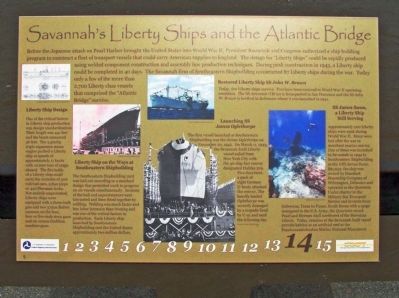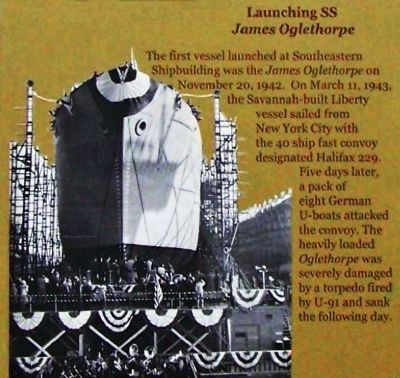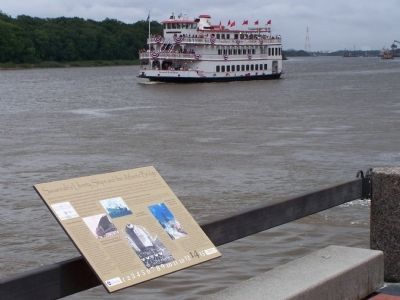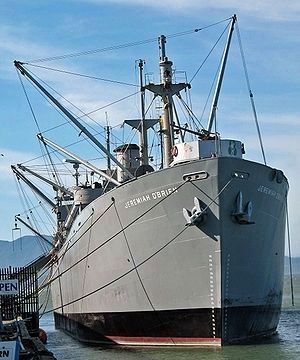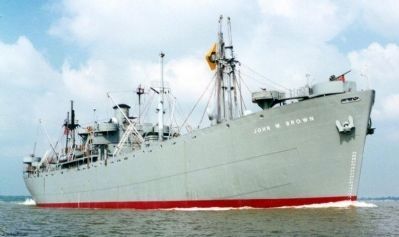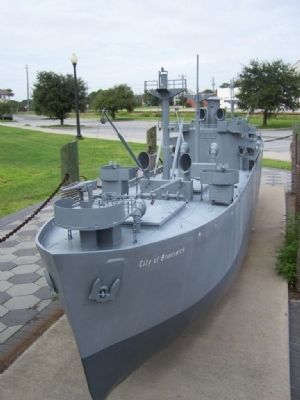Hitch Village/Fred Wessels Homes in Savannah in Chatham County, Georgia — The American South (South Atlantic)
Savannah's Liberty Ships and the Atlantic Bridge
Before the Japanese attack on Pearl Harbor brought the United States into World War II, President Roosevelt and Congress authorized a ship building program to construct a fleet of transport vessels that could carry American supplies to England. The design for "Liberty Ships" could be rapidly produced using welded component construction and assembly line production techniques. During peak construction in 1943, a Liberty ship could be completed in 40 days. The Savannah firm of Southeastern Shipbuilding constructed 87 Liberty ships during the war. Today only a few of more than the 2,700 Liberty class vessels that comprised the "Atlantic Bridge" survive.
Liberty Ship Design
One of the critical factors in Liberty ship production was design standardization. Their length was 441 feet and the beam measured 56 feet. The 2,500 hp triple expansion steam engine pushed a Liberty ship at speeds of approximately 11 knots with 10,000 tons of cargo aboard. The five holds of a Liberty ship could carry the contents of 300 railroad cars, 2,840 jeeps or 440 Sherman tanks. Not entirely unprotected, Liberty ships were equipped with a three-inch gun and two 37 mm Bofors cannons on the bow, four or five-inch stern guns and six 20 mm Oerlikon machine guns.
Liberty Ship on the Ways at Southeastern Shipbuilding
The Southeastern Shipbuilding yard was laid out according to a standard design that permitted work to progress on six vessels simultaneously. Sections of the hull and superstructure were fabricated and then fitted together by welding. Welding was much faster and less labor intensive than riveting and was one of the critical factors in production. Each Liberty ship launched by Southeastern Shipbuilding cost the United States approximately two million dollars.
Restored Liberty Ship SS John W. Brown
Today, few Liberty ships survive. Two have been restored to World War II operating condition. The SS Jeremiah O'Brien is homeported in San Francisco and the SS John W. Brown is berthed in Baltimore where it was launched in 1942.
Launching SS James Oglethorpe
The first vessel launched at Southeastern Shipbuilding was the James Oglethorpe on November 20, 1942. On March 11, 1943, The Savannah-built Liberty vessel sailed from New York City with the 40 ship convoy designated Halifax 229. Five days later, a pack of eight German U-boats attacked the convoy. The heavily loaded Oglethorpe was severely damaged by a torpedo fired by U-91 and sank the following day.
SS James Swan a Liberty Ship Still Serving
Approximately 200 Liberty ships were sunk during World War II. Many were lost after the war in merchant marine service. One of those was launched in Savannah in 1944 by Southeastern Shipbuilding as the USS James Swan. By 1952, the ship was owned by Standard Steamship Company of Wilmington, Delaware and operated as the Quartette. Under charter to the Military Sea Transport Service and in route from Galveston, Texas to Pusan, South Korea with a cargo consigned to the U.S. Army, the Quartette struck Pearl and Hermes Atoll northwest of the Hawaiian Islands.
Today, remains of the Savannah-built vessel provide habitat as an artificial reef at the Papahanaumokuakea Maritime National Monument.
Erected 2009 by U.S. Dept. of Transportation Federal Highway Administration, Georgia Dept. of Transportation. (Marker Number 14.)
Topics and series. This historical marker is listed in these topic lists: War, World II • Waterways & Vessels. In addition, it is included in the Lost at Sea series list. A significant historical month for this entry is March 1865.
Location. 32° 4.772′ N, 81° 4.946′ W. Marker is in Savannah, Georgia, in Chatham County. It is in Hitch Village/Fred Wessels Homes. Marker is on East River Street, on the left when traveling east. East of E. Broad St. Ramp, Riverside. Touch for map. Marker is in this post office area: Savannah GA 31401, United States of America. Touch for directions.
Other nearby markers. At least 8 other markers
are within walking distance of this marker. Savannah's Early Economy (within shouting distance of this marker); King Cotton (within shouting distance of this marker); Native Americans on the Georgia Coast (about 300 feet away, measured in a direct line); 1996 Olympic Yachting Cauldron (about 500 feet away); Crossing the Savannah (about 500 feet away); The Trustees' Garden (about 600 feet away); Old Harbor Light (about 600 feet away); New World Medical Plants (about 700 feet away). Touch for a list and map of all markers in Savannah.
Credits. This page was last revised on February 8, 2023. It was originally submitted on June 4, 2009, by Mike Stroud of Bluffton, South Carolina. This page has been viewed 3,405 times since then and 39 times this year. Photos: 1, 2, 3, 4, 5, 6. submitted on June 4, 2009, by Mike Stroud of Bluffton, South Carolina. • Craig Swain was the editor who published this page.
